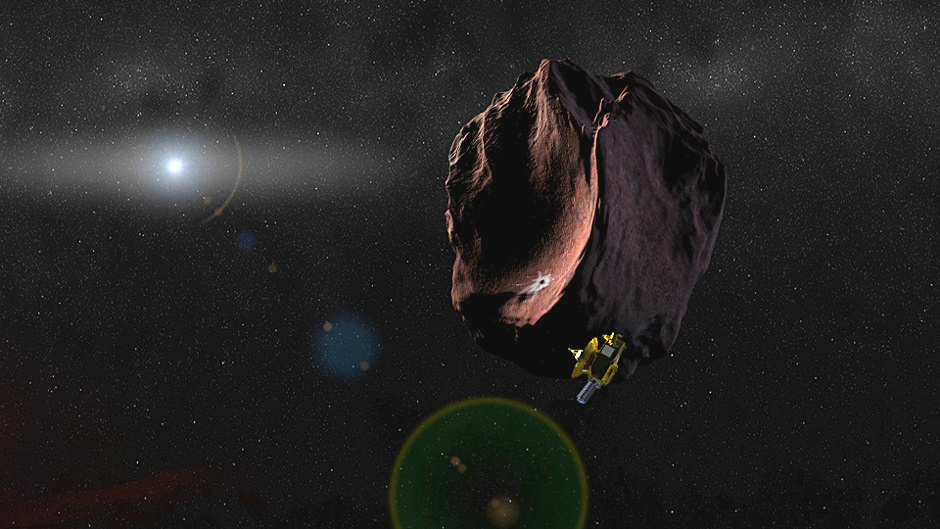
The New Horizons mission has revolutionized our understanding of Pluto and its moons, after conducting the first-ever flyby last summer. These mysterious worlds were finally seen up close, and this new view created as many, if not more, new questions as it answered old ones. While the flyby may be long over now, the spacecraft itself is still in excellent health and continues to plunge deeper into the Kuiper Belt at the outer fringes of the Solar System. Scientists have been eager for New Horizons to continue exploring this region farther out past Pluto, and now a proposal has been formally submitted to NASA to do just that. This extended mission will conduct a flyby of at least one more Kuiper Belt Object (KBO) and last until 2021.
This new mission has been dubbed “KEM,” or Kuiper Belt Extended Mission. There are many other small bodies in the Kuiper Belt besides Pluto, and mission scientists would love to be able to visit some of them as well. Pluto has already turned out to be more geologically active than anticipated, so what about some of these other ones? Granted, they are all smaller than Pluto, but being able to compare some of them directly with Pluto and its moons would be invaluable.
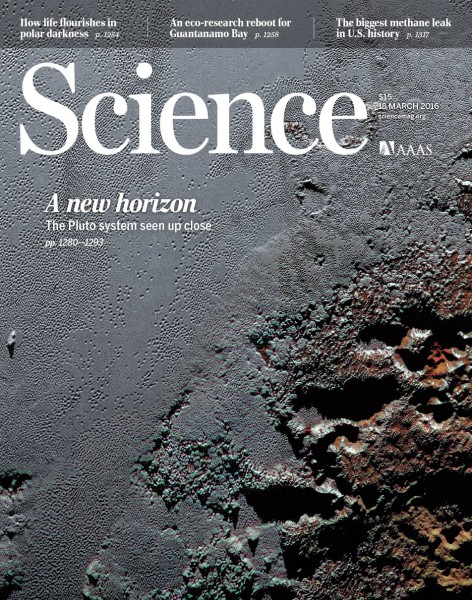
The next close flyby would be of a KBO called 2014 MU69, on Jan. 1, 2019. This flyby has been discussed before on AmericaSpace, but now would be part of a larger extended mission plan. 2014 MU69 is much smaller than Pluto, only about 13 to 25 miles (21 to 40 kilometers) across (similar in size to Mars’ two tiny moons), but New Horizons would fly past at a distance of only about 1,900 miles (3,000 kilometers), four times closer than the Pluto flyby. New Horizons has already completed four necessary course corrections to put it on the right path to 2014 MU69.
This next flyby will be the centerpiece of the extended mission, but there are other primary objectives as well, including:
- Make distant flyby observations of about 20 other KBOs during 2016-2020, determining their shapes, satellite populations, and surface properties—something no other mission or ground-based telescope can.
- Make sensitive searches for rings around a wide variety of KBOs during 2016-2020.
- Conduct a heliospheric transect of the Kuiper Belt, making nearly continuous plasma, dust, and neutral gas observations from 2016 to 2021, when the spacecraft reaches 50 astronomical units (AU) from the Sun.
- Potentially conduct astrophysical cruise science in 2020 and 2021, after the MU69 flyby, if NASA desires.
2014 MU69 was discovered in 2014 by the Hubble Space Telescope, as part of a search for other KBOs which New Horizons could possibly fly past. It is 500,000 times less massive than Pluto, but 1,000 times more massive than Comet 67P, which the Rosetta spacecraft is currently still orbiting. This means it is an intermediate-sized body in the outer Solar System, more like an asteroid, which would help scientists better understand the process of planetary accretion in the early Solar System billions of years ago.
With the spacecraft still in excellent heath, the plan is to use all seven of its scientific instruments to study 2014 MU69, including detailed global and high-resolution mapping, color mapping, compositional mapping, searching for moons, studies of surface properties, and searching for an atmosphere. Remote observations would begin 100 days out from closest approach, in September 2018, and continue until the first week of 2019. It would take about 20 months to downlink all of the data collected from New Horizons back to Earth. Even now, the spacecraft is still sending back data from its Pluto flyby, and will do so until October this year. A flyby of 2014 MU69 would be the farthest that any spacecraft has studied another object in the Solar System.
The Kuiper Belt is a vast region out beyond Neptune, which includes Pluto, and is still unexplored apart from Pluto and the previous two Voyager spacecraft. New Horizons is uniquely able to study this region as never before, and will do so, pending the acceptance of the new KEM proposal. As noted by Alan Stern, Principal Investigator of the mission:
“The Kuiper Belt is a rich scientific frontier. Its exploration has important implications for better understanding comets, the origin of small planets, the Solar System as a whole, the solar nebula, and dusty Kuiper Belt-like disks around other stars, as well as for studying primitive material from our own Solar System’s planet formation era. The exploration of the Kuiper Belt and KBOs like MU69 by New Horizons would transform Kuiper Belt and KBO science from a purely astronomical pursuit, as it is today, to a geological and geophysical pursuit.”
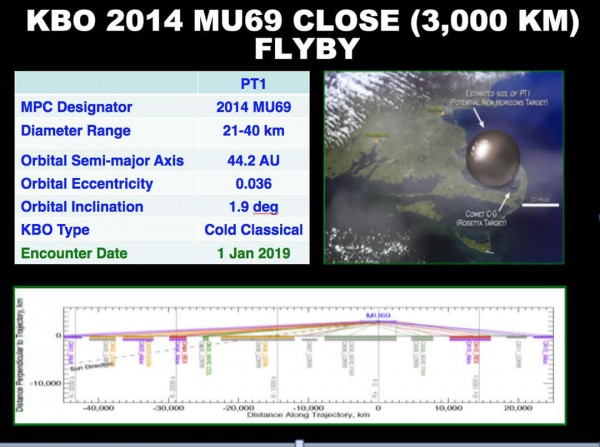
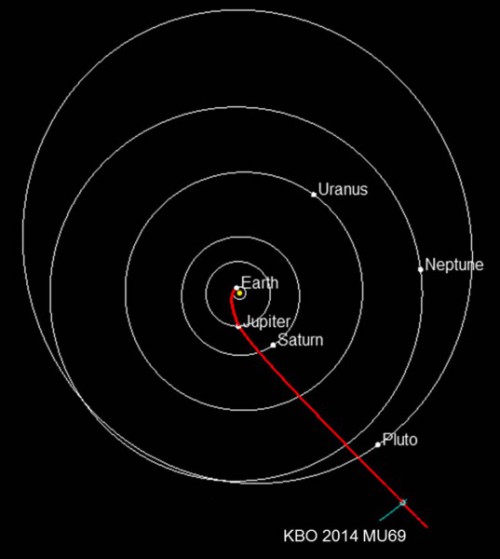
Strong science community support for the exploration of the Kuiper Belt by New Horizons has been expressed by both NASA’s own Outer Planets Assessment Group (OPAG) and Small Bodies Assessment Group (SBAG). In April 2014, these two advisory committees stated that “SBAG and OPAG are united in affirmation of the tremendous scientific value of exploring a primitive KBO in situ, where it remains essentially unaltered since the time of planetesimal formation,” and that ‘The scientific bounty of a spacecraft encounter with a primitive KBO is realizable in our lifetimes, but only with New Horizons … No other mission currently in flight, in build, or in design will reach the Kuiper Belt.”
The proposal now needs to be peer-reviewed by NASA. An approval is required for New Horizons to continue, otherwise funding will end and the spacecraft will be turned off in December. With everything still working smoothly on the spacecraft, it would be disappointing indeed if the proposal was rejected, but Stern is confident it won’t be. According to Stern, we should know the answer by June or July of this year. As also noted by John Grunsfeld, chief of the NASA Science Mission Directorate in Washington:
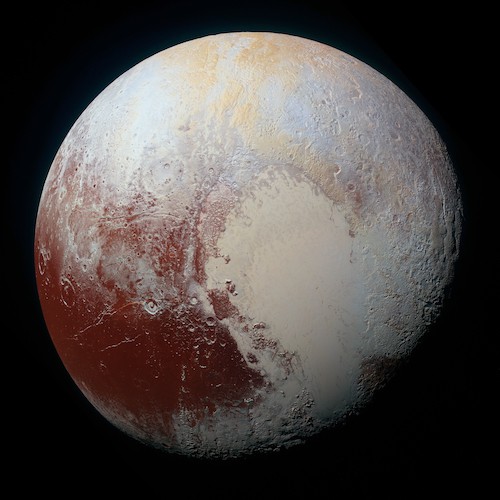
“Even as the New Horizon’s spacecraft speeds away from Pluto out into the Kuiper Belt, and the data from the exciting encounter with this new world is being streamed back to Earth, we are looking outward to the next destination for this intrepid explorer. While discussions whether to approve this extended mission will take place in the larger context of the planetary science portfolio, we expect it to be much less expensive than the prime mission while still providing new and exciting science.”
Smaller Kuiper Belt Objects (KBOs) like 2014 MU69 are thought to be ancient remnants of the rocky building blocks which formed larger bodies like Pluto billions of years ago. They are primordial leftovers from the formation of the early Solar System, much like comets and asteroids. They could provide valuable clues as to how dwarf planets like Pluto and others formed, as well as other larger planets in the Solar System.
The findings by New Horizons at Pluto have been compiled in detail in five new papers in the March 18 edition of the journal Science. Pluto has been revealed to be a bizarre little world with a layered and hazy atmosphere, nitrogen ice plains and glaciers, mountains of solid water ice, methane snow on mountain peaks, odd “snakeskin” terrain, and ancient rivers and lakes of liquid nitrogen. It is even thought there might be a subsurface ocean of water, similar to moons like Europa, Enceladus, and others. Pluto has been and still is more geologically active than many scientists had previously thought possible.
“All we can say is that we think that Pluto has an ocean and we think that this ocean has survived to the present day,” said William McKinnon at Washington University in St. Louis. “It’s the kind of ocean that is deep inside the interior of Pluto, in total darkness. But, it would lie between a floating water ice shell and the rocky interior, so it would be in contact with rock. There would be a modest amount of heat leaking out.”
“Observing Pluto and Charon up close has caused us to completely reassess thinking on what sort of geological activity can be sustained on isolated planetary bodies in this distant region of the Solar System, worlds that formerly had been thought to be relics little changed since the Kuiper Belt’s formation,” said Jeff Moore, lead author of the geology paper from NASA’s Ames Research Center, Moffett Field, Calif.
“This is why we explore,” said Curt Niebur, New Horizons program scientist at NASA Headquarters in Washington. “The many discoveries from New Horizons represent the best of humankind and inspire us to continue the journey of exploration to the Solar System and beyond.”
Follow our New Horizons mission page for regular updates.
Be sure to “Like” AmericaSpace on Facebook and follow us on Twitter: @AmericaSpace
Missions » New Horizons »




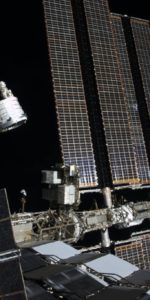
Approval? A no-brainer! Yes, “This is why we explore.”
Yep!